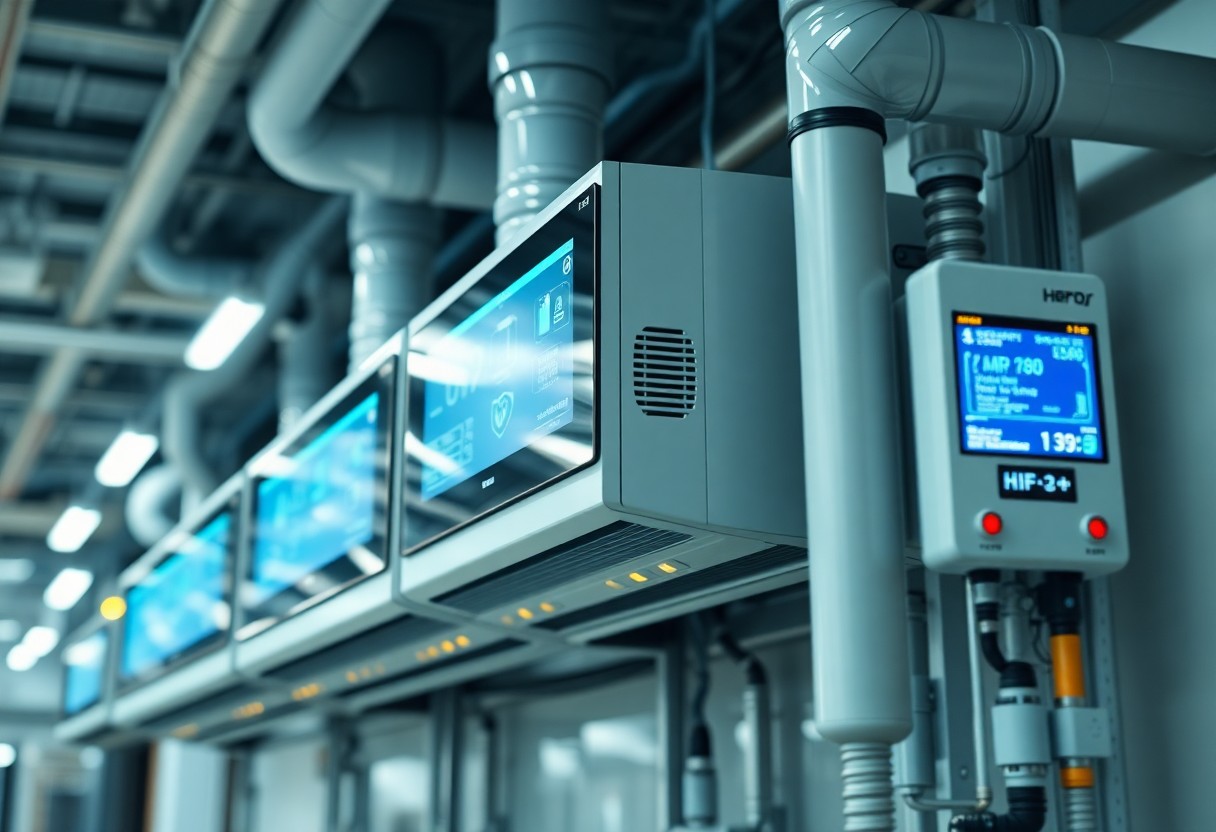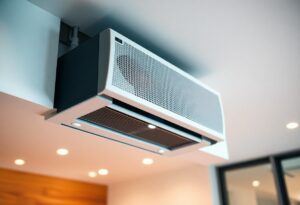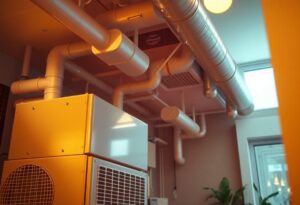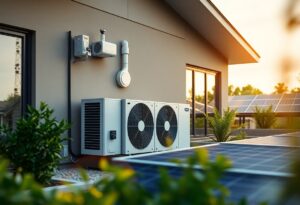Most people are unaware that artificial intelligence (AI) and the Internet of Things (IoT) are fundamentally transforming the HVAC industry, enhancing both efficiency and user experience. By integrating smart technologies, your HVAC system can now dynamically adjust to your needs, ensuring optimal comfort while reducing energy consumption. This revolution not only leads to significant cost savings but also improves air quality and promotes sustainability. Discover how these innovations are reshaping HVAC technology, making your environment more comfortable and eco-friendly.
Key Takeaways:
- Integration of AI and IoT enhances HVAC system efficiency through real-time data analysis and predictive maintenance.
- Smart sensors and IoT devices enable remote monitoring and control, allowing users to optimize energy consumption and comfort levels.
- AI algorithms can analyze historical data to forecast usage patterns and make automatic adjustments, reducing energy waste.
- Enhanced indoor air quality is achievable through IoT-enabled HVAC systems that monitor air pollution levels and adjust filters accordingly.
- Cost savings arise from decreased energy consumption and potential reduction in operational expenses due to improved system performance.
- Predictive analytics provided by AI can lead to timely equipment servicing, ultimately extending the lifespan of HVAC units.
- Integration of AI and IoT improves user experience by offering personalized climate settings based on occupant preferences and behaviors.
Understanding HVAC Technology
For many homeowners and business operators, understanding HVAC (Heating, Ventilation, and Air Conditioning) technology is necessary for maintaining a comfortable and healthy indoor environment. This comprehensive system encompasses the heating and cooling components, ventilation mechanisms, and air quality controls that work together to ensure that your space remains conducive to living and working. Effective HVAC systems manage the temperature, humidity, and airflow, while also filtering out contaminants from the air, thereby promoting a healthier atmosphere for you and your loved ones or colleagues.
Overview of Traditional HVAC Systems
An HVAC system is typically divided into four main components: heating, cooling, ventilation, and controls. Traditional systems often rely on mechanical components such as compressors, blowers, and heat exchangers to regulate temperature and airflow. You might find these systems being controlled through a simple thermostat, which requires manual adjustments to meet your comfort levels. While these systems have served us well over the years, there is a growing need for smarter, more efficient solutions that can adapt to your lifestyle and optimize energy usage.
Limitations of Conventional Approaches
Technology has advanced significantly in recent years, yet many traditional HVAC systems struggle with outdated methodologies and lack the flexibility needed to meet modern demands. One of the main limitations of conventional approaches is their reliance on fixed schedules and manual controls, which can lead to wasted energy. For instance, if you leave your home for an extended period, your system may continue to operate as if you were present, resulting in unnecessary energy consumption and inflated utility bills. Additionally, these systems often lack real-time data analytics, preventing you from making informed adjustments for enhanced efficiency.
A further concern with conventional HVAC systems is their inability to effectively monitor and adapt to environmental changes. If your system is not equipped with intelligent sensors or smart controls, it may struggle to maintain ideal indoor air quality, especially in the face of fluctuating outdoor conditions. This not only impacts your comfort but could also pose health risks if ventilation systems fail to respond adequately to humidity or pollution levels. Understanding these limitations is necessary for you to make informed choices about upgrading to more advanced HVAC technology that can meet the needs of today’s dynamic living and working environments.
The Role of Artificial Intelligence in HVAC
While traditional HVAC systems rely heavily on human input and manual adjustments, the integration of artificial intelligence into these systems has led to transformative advancements. By utilizing AI algorithms, you can automate and optimize operations, resulting in improved performance and reduced operational costs. As AI continuously learns from your system’s data, it enhances its decision-making processes, making your HVAC system not just reactive but proactive in managing your climate control needs.
Predictive Maintenance and Diagnostics
With the implementation of AI, predictive maintenance has become a game-changer for HVAC systems. Instead of waiting for equipment to fail, AI can analyze data from your heating and cooling systems to anticipate potential problems before they arise. This allows you to carry out maintenance on your HVAC systems when it is truly needed—reducing downtime and extending equipment lifespan. By focusing on diagnostics, you can also ensure that issues are swiftly identified and addressed, ultimately improving your overall system reliability.
Energy Optimization and Efficiency
Behind the scenes, AI enhances your HVAC system’s efficiency by analyzing energy consumption patterns and making real-time adjustments. This means that your heating and cooling systems can adapt to changes in occupancy or weather conditions dynamically. As a result, you can enjoy a comfortable environment while also realizing significant savings on your energy bills. By leveraging smart algorithms, you can ensure that energy is used most efficiently, reducing waste and contributing positively to your bottom line.
Further, the optimization you achieve with AI does not just stop at managing your HVAC systems better; it extends to all aspects of energy usage in your buildings. By implementing machine learning models, you gain insights into how different areas of your environment interact with HVAC demands. This can lead to further reductions in energy consumption, enhancing your sustainability efforts while maintaining comfort for occupants. By optimizing every aspect of energy use, you’re investing not only in your comfort but also in the health of the planet.
The Impact of the Internet of Things (IoT) on HVAC
Many individuals may not realize the extent to which the Internet of Things (IoT) is influencing HVAC technology. By enabling devices to connect and communicate, IoT allows for a level of efficiency and convenience that was previously unattainable. You can now take advantage of real-time data that can help you optimize your HVAC system, resulting in improved energy efficiency, reduced operational costs, and enhanced comfort levels in your home or business.
Smart Sensors and Real-Time Monitoring
Above all, the implementation of smart sensors within your HVAC system acts as the backbone of IoT technology. These sensors continuously collect and transmit data regarding temperature, humidity, and air quality directly to your smartphone or other connected devices. When you have real-time monitoring capabilities, you can make informed decisions regarding system performance, proactively addressing issues before they escalate into costly repairs.
Enhanced User Control and Automation
Between the integration of smart thermostats and IoT technology, user control over HVAC systems has reached new heights. You can easily schedule temperature settings, monitor energy consumption, and even customize your HVAC operation from virtually anywhere. The convenience offered by mobile apps allows you to adjust your system based on specific preferences, ensuring that your indoor environment is always comfortable.
Due to the capabilities provided by IoT, you can automate your HVAC system to function optimally throughout the day. Automated scheduling and geofencing features enable your system to adjust based on your location or routine, providing comfortable temperatures when you are home while reducing energy consumption when you are not. This leads to cost savings on your energy bills and a smaller environmental footprint, making the technology not only beneficial for your wallet but also for the planet.
Integration of AI and IoT in HVAC Systems
After recognizing the benefits of combining AI with the Internet of Things (IoT), many HVAC systems have started to shift towards this integration. By leveraging AI algorithms, these systems can analyze data collected from various IoT devices, enabling them to make real-time adjustments to optimize energy consumption and maintain ideal indoor temperatures. Imagine a system that not only responds to your commands but also anticipates your needs by learning your preferences over time. This personalization is set to revolutionize how you interact with your home or workplace environment, ultimately resulting in enhanced comfort and energy savings.
Additionally, the integration of AI and IoT has led to advancements in predictive maintenance, reducing unexpected breakdowns of HVAC equipment. This proactive approach not only extends the lifespan of your system but can significantly lower your maintenance costs. Your HVAC system can potentially send out alerts about performance issues before they escalate into major problems, helping you avoid costly repairs. As this technology continues to evolve, the future of HVAC systems looks promising, aligning efficiency with customer satisfaction.
Case Studies of Successful Implementations
Along the journey of innovation, several case studies demonstrate the effectiveness of implementing AI and IoT within HVAC systems. Here are some standout examples:
- Company A achieved a 15% reduction in energy costs by deploying IoT-enabled sensors that provided real-time monitoring and AI-driven analytics for their HVAC systems.
- Company B reported an increase in equipment lifespan by 30% due to predictive maintenance supported by AI algorithms, minimizing downtime.
- Company C implemented smart HVAC controls that adjusted temperature based on occupancy patterns, resulting in a 25% energy savings during peak hours.
- Company D utilized AI to analyze data from IoT devices, allowing for automatic adjustments to air quality, which improved user satisfaction ratings by 40%.
Challenges and Considerations
Across the landscape of integrating AI and IoT into HVAC systems, you may encounter several challenges and considerations that warrant your attention. One of the primary concerns is the need for robust cybersecurity measures. As your HVAC systems become more interconnected, they also become more vulnerable to potential cyber threats. It is necessary to implement strong encryption and regular security updates to protect your sensitive data and overall system functionality. Additionally, the initial investment costs for these advanced technologies can be significant, which may require careful budgeting and planning on your part.
Another critical aspect to consider is the complexity of data management. As your HVAC system gathers vast amounts of data, you must ensure you have the appropriate tools and expertise to analyze this information effectively. Failing to do so could lead to missed opportunities for optimization and efficiency. In essence, while the integration of AI and IoT presents numerous advantages in revolutionizing HVAC technology, you should be prepared to navigate these challenges to fully realize their potential benefits.
Future Trends in HVAC Technology
Not only is the HVAC industry witnessing a technological evolution, but it is also gearing up for future trends that harness the potential of data analytics, automation, and remote management. Enhanced functionalities such as smart thermostats, predictive maintenance systems, and integrated climate control are becoming the norm rather than the exception. These features will allow you to achieve optimum energy efficiency while reducing operational costs and ensuring your comfort. As we move forward, expect HVAC systems to become even more interconnected, providing real-time data that furthers operational efficiency and user experience.
Emerging Innovations
Across various sectors, innovations fueled by artificial intelligence (AI) and the Internet of Things (IoT) are pushing the boundaries of what HVAC systems can achieve. Smart HVAC units equipped with self-learning algorithms can analyze your behavior and preferences, adjusting temperatures and air quality automatically to suit your needs. Additionally, IoT-connected sensors can monitor air quality, humidity, and other environmental factors, providing you with alerts and recommendations to enhance your living conditions. The integration of augmented reality (AR) in maintenance training is also reshaping how technicians conduct repairs, ultimately leading to quicker resolutions and minimized downtime.
The Role of Sustainability
By adopting sustainable HVAC practices, you not only contribute to a greener planet but also enjoy long-term savings. The use of renewable energy sources, like solar panels and geothermal systems, is becoming increasingly popular in HVAC technology. Furthermore, innovations like variable refrigerant flow (VRF) systems and high-efficiency heat pumps reduce energy consumption while enhancing performance. These systems utilize less energy compared to traditional HVAC units, which translates to lower utility bills and reduced greenhouse gas emissions. Ultimately, embracing these sustainable practices will allow you to take pride in your ecological footprint while ensuring comfortable living spaces.
HVAC systems are transitioning from traditional energy-consuming designs to models that prioritize sustainability, focusing on energy efficiency and lower emissions. Innovations like smart controls and renewable energy integration help decrease reliance on fossil fuels, promoting a healthier environment. You will find that investing in a sustainable HVAC system not only benefits your pocket in the long run but also plays a vital role in reducing the overall impact of climate change, aligning your personal values with responsible consumerism.
Final Words
Taking this into account, you can see how AI and IoT technologies are transforming the HVAC industry, offering numerous benefits that enhance both efficiency and comfort. By integrating smart technology into your HVAC systems, you empower yourself to monitor and control your environment in real-time, ensuring optimal conditions while reducing energy consumption. These advancements not only contribute to significant cost savings but also promote sustainability, aligning with your goals of reducing your carbon footprint.
As you embrace these innovations, you position yourself at the forefront of a movement that prioritizes both user experience and environmental responsibility. By leveraging data-driven insights, you can make informed decisions about your HVAC systems, adapt to changing conditions, and create a healthier indoor environment. Ultimately, investing in AI and IoT technology is not just about enhancing your HVAC system; it’s about taking control of your space and contributing to a smarter, more connected future.
FAQ
Q: How are AI and IoT transforming HVAC systems?
A: AI and IoT technologies are revolutionizing HVAC systems by enabling real-time monitoring, predictive maintenance, and smarter energy management. IoT sensors collect data on temperature, humidity, and occupancy, which AI algorithms analyze to optimize HVAC performance, reduce energy consumption, and enhance indoor air quality.
Q: What are the benefits of integrating AI with HVAC systems?
A: The integration of AI with HVAC systems leads to several benefits, including increased energy efficiency, improved comfort for occupants, and lower operational costs. AI can efficiently analyze vast amounts of data to predict potential system failures, allowing for timely maintenance and minimizing downtime.
Q: How does IoT improve HVAC maintenance?
A: IoT enhances HVAC maintenance by providing real-time monitoring of system components. Connected sensors can identify issues before they escalate into major problems, allowing for proactive maintenance. This reduces the likelihood of breakdowns and extends the lifespan of the equipment.
Q: What role does data analytics play in HVAC optimization?
A: Data analytics plays a significant role in HVAC optimization by processing data collected from IoT devices. This data can reveal usage patterns, performance metrics, and environmental conditions, enabling HVAC systems to adjust settings dynamically for efficient operation and optimal comfort.
Q: Can AI and IoT help in achieving energy efficiency certifications?
A: Yes, AI and IoT can aid in achieving energy efficiency certifications by providing detailed insights into energy consumption and helping to identify opportunities for conservation. Automated adjustments by smart HVAC systems can align with standards set by certification programs, supporting sustainability goals.
Q: What is the future of HVAC technology with AI and IoT?
A: The future of HVAC technology with AI and IoT is promising, as systems are expected to become increasingly autonomous and responsive. Innovations such as machine learning algorithms and advanced analytics will lead to more intelligent systems capable of learning from user behavior and environmental changes, offering even higher levels of comfort and efficiency.
Q: How does the integration of AI and IoT address indoor air quality issues?
A: The integration of AI and IoT addresses indoor air quality issues by continuously monitoring air quality parameters such as pollutants and ventilation rates. AI can analyze this data to make real-time adjustments to HVAC operations, ensuring that indoor environments remain healthy and comfortable for occupants.
This post has been written by Team HVAC Talk Magazine. Stay informed and connected with the latest in HVAC—join us for expert advice, troubleshooting tips, and news updates. Don’t miss out, follow us now! #HVACExperts #HVACTips #StayInformed #HVACProTalk.
Learn more and join our mailing list for updates.









